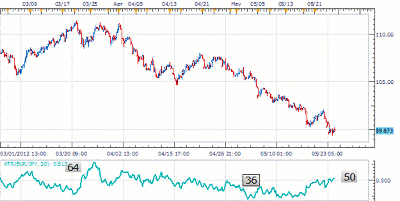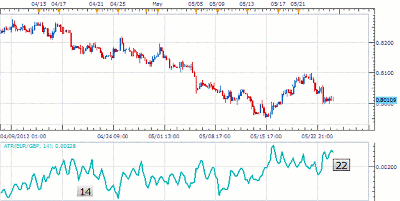The average true range (ATR) indicator can be a helpful tool for currency traders when setting stop levels and managing trades, explains Walker England of DailyFX.com, referencing a recent EUR/JPY chart.
Managing a trade can be one of the most difficult tasks a trader faces. Lucky for us there are a variety of indicators we can use to help in the process. Our last discussion, March 10 Chart of the Day, had us implementing a trailing stop using PSAR. Today we will focus on another method, setting fixed stops using the ATR indicator.
Average true range (ATR) is an excellent indicator found inside of Marketscope 2.0 that can be used to establish initial stop levels on a trade. The indicator is another creation of Welles Wilder and was designed to measure market volatility. It achieves this by comparing previous highs and lows of a currency pair for a set number of periods. The greater the difference between these two points, regardless of market direction, the higher ATR will read.
See also: Trading Basics: Average True Range
Traders can use ATR to actively manage their position in accordance to volatility. The greater the ATR reading is on a specific pair, the wider the stop that should be used. This makes sense, as a tight stop on a particularly volatile currency pair is more prone to be executed.
As well, a wide stop on a less-volatile pair may make stops unnecessarily large. Let’s take a look at some examples. A good rule is to place initial stops at minimum 1X the ATR amount for your trade.
Above we have a graph depicting the strong downtrend developing on the EUR/JPY pair for the month of May. We have taken a variety of trades on this pair using many different strategies. One constant that remains the same is that a stop is needed on the position.
Reading ATR, we can see for this time period that volatility has changed. Currently on the four-hour graph, ATR is reading 50 and has been increasing. This means we need to be prepared for more volatility and use bigger stops, as opposed to previous levels where ATR held a reading of 36.
Finally, ATR can also be a gauge for the placement of limit orders. Using the four-hour EUR/GBP chart above, a 1X ATR stop on a new position would be placed 22 pips away from our entry. Using a positive risk/reward ratio, we can then determine our limit levels. A 1:2 risk/reward setting would mean doubling our ATR, setting initial profit targets a minimum of 44 pips away.
By Walker England of DailyFX.com




















